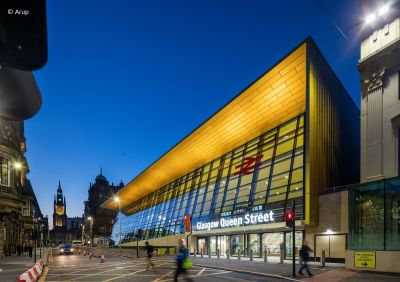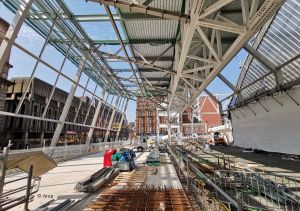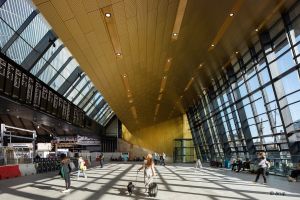Glasgow Queen Street Station
Structural Steel Design Awards 2021 - Award
Glasgow Queen Street station is Scotland’s third busiest railway station, providing rail connections to and from the city to the wider Glasgow area as well as throughout the country.
Popular amongst commuter and leisure travellers, the station won the 2020 World Cup of Stations and the number of people using the station is set to increase by 40 per cent to reach 28 million by 2030. To manage this growth in passenger numbers, it was necessary to extend the existing platforms to accommodate longer trains and electrification of the lines as part of the larger Edinburgh Glasgow Improvement Programme (EGIP) scheme. With room for expansion to the north restricted by the width of the tunnel throat, it was necessary to also extend the platforms into the existing station concourse to the south. In order to make space for the platform extensions, a new concourse and station entrances, Network Rail compulsorily purchased and subsequently demolished the buildings between the station and Glasgow’s George Square.
The new station concourse is housed in a striking contemporary glass-fronted building which wraps around the historic 1880s train shed and forms the centrepiece of the £120 million station redevelopment.
Improving passenger experience was a key focus of the design and the concourse is shaped to respond to pedestrian movement, while the dramatic roof structure above floods the station with daylight and creates a gateway to the city. The concept creates new perspectives of the Category-A listed train shed, putting the fine Victorian structure at the heart of the design.
The station remained open throughout the redevelopment with careful and complex phasing allowing construction to proceed whilst minimising disruption to passengers.
A column-free concourse is achieved through a 54m-spanning 4.5m-deep steel box truss. Secondary trusses cantilever from this structural spine towards the train shed and the station frontage, which incorporates 15m-high RHS columns which restrain the curtain walled façade. The 80-tonne box truss was pre-cambered by over 60mm to remove dead load deflections, fabricated on the ground and lifted into place overnight with two 500-tonne cranes. The roof has a triangular form, and the sloping gold coloured aluminium soffit demands that the secondary trusses taper to create a thin leading edge where they meet the south and west façades.
The buildings demolished to make way for the new development provided lateral restraint to the base of the fan light of the historic train shed. During demolition, this was lateral propped and is now restrained by the new roof structure. This has been achieved without intermediate columns down to the concourse, by using a sliding universal joint, which provides lateral restraint but still permits vertical and rotational movement between the new and old structures. The connection occurs at the end of a 7m-long cantilever from the spine truss across the concourse. A cranked RHS is used to form the unpropped cantilever to minimise the number of members and maximise the available views of the train shed from concourse level.
Office accommodation for train station staff occupies the upper levels of the building on the west side. This area is constructed over the top of the existing underground low-level station which was created in the 1890s with minimal headroom below the already existing 1880s train shed. The existing bridge structure could not sustain the point loads from new columns, so a 38m-span storey-high truss was constructed to supporting the new office block. The truss is supported on pile caps behind the existing retaining wall to the low-level station.
The storey-high truss was lifted in sections overnight during station close, with daytime commuters protected from the elements and overhead works by passenger tunnels.
The western side of the office block floorplate is supported on 1050mm-deep plate girders which span 22m over the low-level station, supported on new pile caps at platform level. Suspended floors to concourse and upper levels are formed from concrete slabs on metal decking acting compositely with steel beams.
For security reasons, the structure incorporates a good level of redundancy, whilst still providing minimal obstruction to the passenger concourses. Despite an irregular column grid and multiple transfers, the structural design has been able to allow for dynamic column removal with ductile connection design forming a key part of the robustness strategy. Similarly, cladding has been designed with blast resistance, whilst still maintaining a slender appearance with clean lines and careful detailing.
Energy use is kept to a minimum by leaving concourse areas unheated and maximising the use of daylight provided by the south facing curtain walling.
Fire protection is provided through intumescent paint to the primary steelwork. To minimise the use of intumescent, studies were carried out to prove that intumescent could be omitted from secondary steelwork and that one-hour protection of primary steelwork would achieve adequate performance compared to the initially specified two-hour protection.
| Architects | BDP and IDP |
| Structural Engineer | Arup |
| Main Contractor | Balfour Beatty |
| Client | Network Rail |
Judges' comment
Providing a 90% increase in passenger capacity this major redevelopment above the low-level platforms was completed whilst the station remained fully functional. It has transformed a drab, unpopular station into one which restores the Victorian train shed and provides an impressive contemporary frontage onto Glasgow’s principal square. An exceptional achievement.






